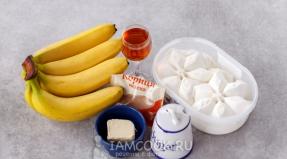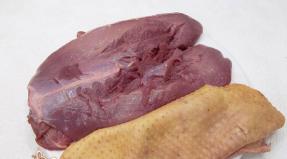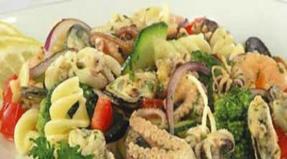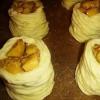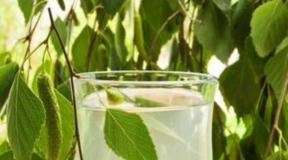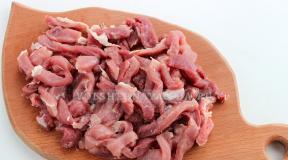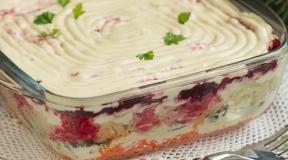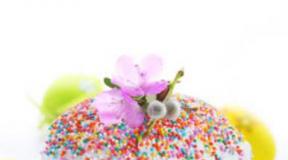How to store fruit at home - general principles, memo and photo ideas. Storage of berries and fruits Recommended storage conditions for fruits and berries
It appears when you, for example, harvest apples, grapes, cabbage in your country house, and so you want to keep it fresh and juicy for as long as possible! What are fruit storage conditions? In this case, it will be useful to listen to the opinion of scientists.
Let's start with apples. Apples, like all living things on,: absorb oxygen and release it. Moreover, they breathe not only on the branch, but also in the storage, being already plucked ... If there is a lot of oxygen in the storage chamber, the fruits breathe actively and ripen too quickly, and then rot and deteriorate. An increased concentration of carbon dioxide, on the contrary, delays the breath of the fruit. However, if there is too much carbon dioxide, this is also bad: the fetus is forced to maintain its vital activity at the expense of internal reserves, loses its juiciness, and soon becomes completely inedible. Fruit storage conditions will be best when some optimal concentrations of oxygen and carbon dioxide are met. But determining the exact ratio of gases is only half the battle. It still needs to be maintained for many months with an accuracy of tenths of a percent!
For this purpose, it is best to purchase a special installation that supports artificial in the refrigerators. The conditions for storing fruits in it are as follows: a few days after the start of storage, apples remove excess oxygen from the air and the optimal composition of the atmosphere is established in the chamber. Apples emitted an excessive amount of carbon dioxide - it will be immediately neutralized by the incoming oxygen.
The conditions for storing grape fruits are aggravated by the mold fungus known to all winegrowers - the main cause of damage to grapes during storage. To combat it, two methods are used: the first is cold, the second is sulfuric smoke. In the first case, the most resistant grape varieties are stored for no more than two months. The second method, until recently, was considered the only way to save grapes for a long time. As in the old days, they were burned, and the smoke was introduced into the refrigerators. But a frequent change in the gaseous environment is again detrimental to berries. They darken, their taste worsens. In addition, sulfuric gas is reactive and poisonous, people have to work in gas masks.
But you can use potassium metabisulfite - a substance that decomposes in air, emits sulfuric gas. Tablets made from a mixture of gelatin and potassium metabisulphite emit sulfuric gas for seven months. In the refrigerating chamber, an environment that is detrimental to the fungus is constantly maintained. At the same time, the concentration of gas is negligible.
What about cabbage? What are the storage conditions for these fruits? During storage, "nebula" falls on the cabbage. The disease undermines the head of cabbage from the inside, its middle darkens, the inner leaves and the stalk begin to rot. The cause of the disease is a violation of gas exchange inside the head of cabbage. Cabbage is stored in the cold, the upper leaves freeze through and no longer allow air to penetrate inside. The inner leaves continue to breathe, consuming the rest of the stored oxygen. Carbon dioxide accumulates inside the head, creating an atmosphere favorable for the development of nebula. Favorable storage conditions for cabbage fruits, in this case, are as follows: the head of cabbage is cut to the middle, thereby ensuring free access of air to the inner leaves. You can also cut the head of cabbage into two halves along the stalk. Here's how it turns out: until now it was believed that whole heads of cabbage are preserved better than halves, but it turned out just the opposite!
Fruits can be stored in unrefrigerated and artificially cooled fruit storages (refrigerators).
Due to the natural cold in autumn, winter and early spring, the temperature and relative humidity of the air are maintained close to optimal. During this period, apples, pears, lemons, quince, tangerines, oranges, the most stale grape varieties are stored in uncooled fruit storages. In spring, the temperature rises in the storage facilities, and the fruits should either be quickly sold or moved to artificially cooled storage facilities. In refrigerators at any time of the year, regardless of the outside temperature, the necessary mode is created.
The fruits are placed in chambers whose walls, floors and ceilings are well insulated. In addition to the chambers where the fruits are located, there are rooms for working, sorting, cooling, defrosting (for warming the fruits before selling).
Stacks are placed perpendicular to the head passage from walls and ceilings that do not have cooling devices, the distance should be 30 and 20 cm, respectively, from ceiling and wall cooling devices - 40 cm. Stacks are placed in pairs with an interval of 10 cm for air circulation. Between each pair of such double stacks leave a passage of 50-60 cm, going from the central passage to the wall.
Boxes in a stack can be stacked in various ways: a well, a tee, a vertical and a checkerboard pattern, a double cage. When stackers and forklifts are used, boxes are usually stacked vertically on pallets. The height of the stack should be 4-6 m, and with manual stacking - 2-2.5 m. A passport is attached to each stack in a conspicuous place, which indicates the pomological, commercial grade, weight, supplier, date of loading, estimated shelf life.
Seed storage. Optimal storage conditions for summer and autumn apples and pears are from 0 to -0.5 °С, winter apples from 0 to -1 °С and relative air humidity is 90-95%. Among the varieties of apples, there are those that, even at temperatures close to 0 ° C, are affected by low-temperature diseases (Antonovka, Pobedel, Parmen golden winter, Aport). Cold-resistant varieties are better stored in chambers with temperatures down to -2 ° C (White rosemary, Kandil sinan, Pepin saffron, Boyken, etc.). Even at low positive temperatures, the fruits of these varieties wither, overripe, are damaged by sunburn, and Pepin saffron - by browning of the heart.
The storage of pome fruits in a controlled atmosphere gives positive results. At a concentration of CO 2 2-3%, 0 2 - 5-6% and nitrogen - 92-97%, individual varieties of apples are stored for 7-8 months. Apples can be waxed before storage. The mixture includes sublimated paraffin, an emulsion mixture of wax and sorbic acid. Storage of apples is also possible under reduced pressure. At the same time, the content of ethylene, the overripening factor, rapidly decreases in the fruit pulp. However, a differentiated approach to vacuum processing modes should be applied: under some modes, ripening is delayed, while in others it is accelerated. The latter concerns the Receipt of unripe fruits, when it is necessary to accelerate ripening.
Pears. For long-term storage (4-6 months), pears of autumn and winter varieties are laid, which are harvested in September-October, for a shorter (1.5-2 months) - autumn and early winter, summer varieties are unsuitable for storage. Late varieties of pears intended for sale can be stored in storage without skill two months after harvest.
direct cooling. For longer periods they are placed in refrigerators. Pears are recommended to be stored at a temperature of -1 ... 0 ° C and a relative humidity of 85-90%. The same varieties at different temperatures are stored for different times. As the temperature decreases, the commercial quality of the fruit increases. Pears of winter varieties ripen slowly, therefore, before selling them, it is recommended to withstand them for several days at a temperature of +15 ... +20 ° C until full ripening.
Positive results during the storage of pears are observed when they are treated with antiseptics. For this purpose, you can use a 0.2% benamil concentrate, the Pra-long preparation is a mixture of esters of fatty acids and polysaccharides.
Preparations are used for fruits with a dense skin and intended for long-term transportation. Thus, fruits from Africa and South America treated with Pralong retain their marketable appearance for 2-3 weeks more than unprocessed fruits, and waste during transportation is reduced by 30%. Like apples, pears can be stored under reduced pressure, high temperature treatments can be used.
Storage of stone fruit, berries. Stone fruits have a thin skin and do not withstand long-term storage.
Plums of varieties Hungarians, Renklody, packed in boxes-trays, lined with paper inside in refrigerators, are stored for 1.5-2 months at a temperature of about 0 ° C and relative humidity of 95%, in plastic bags weighing 0.5-1 kg at a temperature -1 °С - 2-3 months. In a controlled atmosphere, the shelf life increases to 3-4 months.
Apricots are stored in small boxes and boxes-trays at a temperature of about 0 ° C and a relative humidity of -85-90% from 10 days to one month.
Peaches, taken unripe, packed in boxes, when each fruit is wrapped in paper or placed in special pads made of thick paper or cellular cardboard, are stored for 1-1.5 months at a temperature of +1 ... -1 ° C and relative humidity - 85 -95%. Storage in a controlled atmosphere increases the shelf life by 1.5-2 times.
Cherries. Better stored varieties with dense dark pulp. In boxes-trays at a temperature of 0 ... -1 ° C and relative
air humidity - 90-95% shelf life - 10-15 days, in packages of 1 kg - up to one month.
Cherries. Stored in refrigerators at a temperature of -0.5 ... +0.5 ° C and relative humidity - 85-90% for one month, in a controlled atmosphere - up to three months.
Berries storage. Grapes are a complex object of storage, because the berries on the clusters are heterogeneous, differ in weight, chemical composition, and keeping quality. The berries at the base of the bunch have more nutrients, including sugars, and are more storable. Moisture loss and diseases during storage increase as the berries move towards the top of the ridge. Keeping quality of grape varieties is characterized by their ability to retain moisture. Such late varieties include Nimrang, Taifi pink, Taifi white, Isabella, Ararat, etc. Grapes on plantations are packed in open boxes with a capacity of 8 kg. Clusters are placed carefully in one row tightly to one another, stalk up, so as not to damage the berries. Store in refrigerators at a temperature of -+1 ... 0 ° C and relative humidity - 90-95%. Good results are obtained by using potassium metabisulphite. When packing, the trays are lined with paper so that the ends can cover the grapes from the sides and top. Potassium metabisulphite in tablets in the amount of 20 g is evenly laid out on the bottom of the box under the paper. When stored in air, potassium metabisulfite releases S0 2 with the absorption of oxygen and sulfate salts are formed. These compounds have antiseptic and antioxidant properties. The concentration of S0 2 in the boxes reaches 0.002% and remains stable for 4-6 months at a storage temperature of 0 ... + 2 °C.
When storing grapes, fungicides can also be used to treat paper packaging. This allows to reduce the waste of berries during storage by 5 times compared to standard conditions. Storage in a controlled atmosphere also gives positive results.
Cultivated berries are poorly stored. One of the reasons is the release of a large amount of heat during breathing. Black currant berries can be stored up to 5 weeks, red currant - up to 7 weeks, gooseberries - up to 4-6 weeks in refrigerators at a temperature of 0 ° C and a relative humidity of 85-90%.
Raspberries, blueberries, blackberries are cooled immediately after harvesting to the freezing point, after which they can be stored for 7-10 days. Packing in plastic bags is not recommended, as taste and aroma are lost.
In a controlled atmosphere, red currants can be stored for up to two months, blueberries can be stored for 10-15 days without deterioration in quality at a concentration of CO 2 - 6% and 0 2 - 3%. At higher concentrations of CO 2 in the berries, the fermentation process begins.
In some countries, for fruits and berries with a short shelf life, radiation exposure is used. Irradiation extends the shelf life by 2-3 days.
Storage of most berries in chambers without artificial cooling, especially in the places of harvesting, is short - up to 12 hours.
Cowberry berries are stored in clean barrels at a temperature of +3 ... +5 ° C for two months. Can be filled in barrels with cold water up to 7% by weight of berries. Shelf life - 10 months. In places of harvesting in uncooled rooms, lingonberries are stored for up to 10 days.
Cranberries are the most stable during storage. In purses, boxes with a layer of 25-30 cm in unrefrigerated warehouses, cranberries at a temperature of +2 to +15 ° C can be stored without loss for up to 10 months.
Like lingonberries, cranberries can be stored in barrels filled with clean drinking water for up to one year.
Storage of subtropical, tropical and nut fruits. Citrus. The fruits after harvesting are sorted, sized into groups and packed in tight boxes or cardboard boxes of 20-25 kg. The best results are obtained by wrapping each fruit in thin paper and paper impregnated with diphenyl. Storage mode depends on the degree of maturity. So, oranges, lemons with greenery are stored at a temperature of +5 ... +8 ° C, tangerines - +2 ... +3 ° C and relative humidity - 82-85%, ripe fruits are stored at a temperature of +1 .. .+3 °С and relative air humidity 85-90%. During their storage, ethylene is released or it is introduced into the storage chamber.
The duration of storage is ensured by the fact that the skin of citrus fruits is quite dense and thick, and this prevents the evaporation of moisture and warns the fruit from mechanical damage. Essential oils, polyphenols, which are rich in peel, also have an antimicrobial effect. In this regard, lemons can be stored for 5-6 months, in a controlled atmosphere - 6-7, oranges - 4-5, tangerines and grapefruits - 3-4 months. At temperatures below +1 ... +2 ° C, gas exchange is disturbed in citrus fruits and various physiological diseases occur - spotting, pitting.
Extends shelf life and reduces wastage using controlled atmosphere. A feature of gas environments for citrus fruits is the low content or absence of CO 2 , the content of 0 2 - 10-15%.
In many countries, synthetic antiseptics are used when storing citrus fruits. Cardboard storage boxes are saturated with a mixture of molten paraffin and biphenyl. For surface treatment of citrus fruits, nitrogen-containing fungicides are used - cyabendazole at a dose of 6 mg / kg.
Positive results during the storage of tangerines were established when using contact fungicides "Te-ko" in Switzerland, "Batran" - the USA.
Figs are stored at a temperature of +18 ... +20 ° C for no more than one day, at a temperature of 0 ° C - up to 10 days.
Pomegranates packed in boxes up to 30 kg with a lining between layers of wood shavings are stored at a temperature of + 1 ... +2 ° C and a relative humidity of 85-90% from 2 to 6 months.
When storing persimmons, it is better to wrap them in thin paper and put them in boxes lined with paper, the bottom layer is placed with a cup on the bottom, the top one with a cup under the lid. Store persimmon at a temperature of 0 to +1 ° C and relative humidity - 85-90% for two to three months. At higher temperatures ripening is accelerated and shelf life is reduced. Ethylene accelerates ripening, the duration of ripening with ethylene is 3-4 days, without it - 25 days.
Feijoa is stored at a temperature of about 3 ° C for up to one month.
Bananas. The duration of storage of bananas after they are cut from a tree is 35-40 days, including 10-17 days spent on transportation. During this time, by increasing or decreasing the temperature and relative humidity of the air, it is possible to regulate the rate of ripening and the shelf life of the fruit.
When storing green bananas, boxes with them are placed in chambers in stacks of 6-8 pieces high, the temperature must be stable - +12 ... +14 ° С, relative air humidity - 85-90%. Chambers must be ventilated for 30-40 minutes. In this mode, green bananas can be stored for 5-7 days.
Ripening accelerates with increasing temperature and relative humidity. During ripening at a temperature of 16-17 ° C, already on the fifth day, bananas acquire a golden yellow color. From this point on, you can slow down or speed up ripening by adjusting the temperature. With accelerated ripening, the temperature in the chambers is increased to 20 ° C so that the temperature rise of the bananas is no more than 2 ° C per hour, the relative humidity is adjusted to 90-95%. This temperature is maintained for 24 hours, then it is reduced to +18 ... +19 °C. The chambers are poorly ventilated. Increasing and lowering the temperature should be carried out carefully, as the bananas themselves generate a sufficient amount of heat, and softening of the pulp can occur. Accelerates the ripening of ethylene.
Pineapples are also capable of ripening, so fruits of the same degree of maturity should be placed in the chambers.
Ripe pineapples with normal skin color, without signs of overripeness, without mechanical damage and diseases are stored in warehouses at a temperature of +7.5 ... +8 ° C and relative humidity of 85-90% for up to 10-12 days. Storage below 7°C results in hypothermia and reduced quality. The leaves of the rosette become soft, the color of the fruit is dark, the consistency of the pulp is watery, dark.
Green and slightly chilled pineapples under the influence of ethylene at a temperature of +15 ... +16 ° C and a relative humidity of 80-85% ripen in 2-3 days.
Nuts are long-term storage products, due to their low moisture content, their keeping quality is increased by drying after harvesting. Store nuts in clean, dry rooms at a temperature of +15 ... +20 ° C, without sharp fluctuations and relative humidity - 70%.
Walnuts and hazelnuts are stored for one year, pine nuts - 6 months, almonds - 5 years at a temperature of 0 ° C and two years at a temperature of +10 ... +20 ° C.
Kernels of walnuts and pine nuts are stored for no more than 6 months, chestnuts - 1.5-2 months. The shelf life of nuts is limited by fat oxidation and mold.
0
There is nothing complicated in the proper storage of fruits, the main thing is to follow some basic rules. They are in the following points:
- fruit quality;
- suitable storage space;
- purity;
- separate content.
Quality fruits are one of the most important components of long-term fruit storage. The fruit must be picked by hand and must not be rotten or damaged.
 An absolutely suitable place to store fruit is a well-ventilated, cool, rodent- and insect-proof room. Ideal if it is a cellar, basement or garage.
An absolutely suitable place to store fruit is a well-ventilated, cool, rodent- and insect-proof room. Ideal if it is a cellar, basement or garage.
In addition, humidity is of great importance, which ideally should be around 80%. The most suitable temperature in winter is from 1 to 4°C, in spring and summer it should not exceed 12°C. Fruits should not freeze, because in this case they will lose vitamins, as well as taste and smell.
The cleanliness of the premises is a matter of course. If this is a cellar or basement, then it is advisable to disinfect and whitewash the walls. Wash and dry shelves and containers in which food will be stored.
It is good if the fruit boxes are sealed, but do not forget about their need for regular airing.
Separate storage is very important for some types of fruit, especially apples and pears, as they easily take on other odors. Moreover, apples release ethylene, which leads to accelerated ripening of other fruits. Some fruits, such as bananas, can easily spoil other types of fruits.
Where can you store fresh fruit?
In the dry zone, room temperature reaches about 18-20°C with characteristic low humidity. At home, fruits are most often stored on shelves in kitchen cabinets or in the pantry. This is an ideal place for dried fruits, but fresh fruits will not lie here for a long time.
The cold zone is a room with a temperature of 12°C and slightly high humidity. It could be, for example, a basement. It is great for successfully storing both fruits and vegetables.
If you do not have a basement at home, then the fruits can be stored on the balcony.
The cooled zone is a refrigerator, the temperature in which should be in the range from 0 to 5°C. This is the best place for those fruits that you are going to process into compote or consume within a few days. The coldest storage area for fruits is the freezer. In it, frozen fruits can lie for a very long time, but to the detriment of their beneficial properties.
In fridge
 Today, almost every home has a refrigerator. With the advent of this unit, we have long forgotten that some products can be stored outside the refrigerator. Moreover, some types of fruits categorically do not tolerate cold. For example, citrus fruits, bananas and all tropical fruits cannot be stored in it.
Today, almost every home has a refrigerator. With the advent of this unit, we have long forgotten that some products can be stored outside the refrigerator. Moreover, some types of fruits categorically do not tolerate cold. For example, citrus fruits, bananas and all tropical fruits cannot be stored in it.
It is best to put fruits there that you did not eat the day before and are going to do it in the near future. It is better to put too ripe fruits in the refrigerator, because only he can save them.
Of the frost-resistant fruits, strawberries can be noted, they are not afraid of frost and therefore the refrigerator will be the most comfortable place to store them. The berry can safely lie there for several days, packed in small baskets. It is best to divide the strawberries into several parts so that they do not spoil.
In addition to strawberries, fruits such as apples, grapes, ripe pears can be stored in the refrigerator. In this case, the lower temperature limit should not be lower than 8 ° C, and the upper one - above 13 ° C. Sweet cherries, cherries, raspberries, currants, blackberries, blueberries and other berries can lie on the topmost shelf for no more than two or three days.
On the kitchen
 The most popular fruit today is the apple. It can be seen on the table in almost any home. This fruit is ideally stored on clean wooden shelves so that the fruits do not touch each other. Leave a little space between the containers for air. This will allow the apple to ripen faster.
The most popular fruit today is the apple. It can be seen on the table in almost any home. This fruit is ideally stored on clean wooden shelves so that the fruits do not touch each other. Leave a little space between the containers for air. This will allow the apple to ripen faster.
The storage place should not be heavily ventilated, as the fruit will quickly begin to dry out.
Pears can be stored in the same way as apples. Citrus fruits - lemons, oranges, grapefruits and others stay relatively fresh for a long time if wrapped in newspaper, placed in a box and stored in a cool and dark place.
How to store fruits at home
How to store unripe fruit at home
For many fruit growers and traders, the favorite fruit is often the one that is able to ripen outside of natural conditions without loss of taste and quality. These fruits include apples, bananas and pears. Some fruits can also be ripened at home, but their taste will be significantly different from those fruits that ripen on a tree. This applies to pineapples, apricots, peaches and nectarines.
It is advisable to buy plums exclusively ripe, since, most often, they do not ripen at home and remain unripe.
Unripe peaches should be stored at room temperature for 2 weeks to a month, depending on the degree of ripeness.
How long and at what temperature can exotic fruits be stored
 Exotic fruits are usually bought unripe and left to ripen at home. How long it takes the fruit to ripen depends on the conditions under which they will be stored. Their ripening can be accelerated by an apple that releases a special substance.
Exotic fruits are usually bought unripe and left to ripen at home. How long it takes the fruit to ripen depends on the conditions under which they will be stored. Their ripening can be accelerated by an apple that releases a special substance.
Simply put an avocado or mango in a paper bag along with an apple and leave it for a few days at room temperature. Pineapple ripens within 2-3 days.
Uneaten fruit must be wrapped in cling film and refrigerated for a maximum of 2 days.
In no case should bananas be stored in the refrigerator; the temperature for their ripening and storage should not be lower than 14 ° C. If the fruit is stored at a low temperature, it will adversely affect its taste and texture. You will recognize a ripe banana by the characteristic brown spots on the peel, which indicates the presence of fructose. Unripe bananas are hard to digest and have a starchy taste.
Dried fruits
If you regularly consume dried fruits, you should know that they have special conditions for proper storage. The most important thing for this product is humidity and heat. Therefore, it is best to store dried fruits in a dry place at a temperature not exceeding 10-12°C.
If you have stocked up on a large amount of drying, then it must be washed and dried again in the oven. This will help to avoid the risk of mold, which mainly affects under-dried fruits. Choose a special container for storing the product. Glass jars or cotton bags are best. Don't forget about expiration dates. Dried fruits cannot be stored for more than a year.
 In autumn, it's time to think about how to save fruit and stock up on a dose of vitamins for the winter. The most common ways are:
In autumn, it's time to think about how to save fruit and stock up on a dose of vitamins for the winter. The most common ways are:
- Freezing.
This method is widespread not only in our country, but also in the USA, where 20 million families resort to freezing fruits without fear of losing their nutritional value;
- Canning.
This is a convenient and not very complicated process. In order to preserve your favorite fruits with high quality and tasty, you just need to follow certain rules;
- Drying.
Although the fruit loses some vitamins, flavor, and color during this process, it is one of the most popular ways to preserve fruit.
- Do not wash fruits before putting them in the refrigerator.
- Remember that not all foods need to be stored in a cold place, so they will stay fresh longer.
- If fruits are wrapped in cling film, their shelf life will increase significantly.
- Healthy fruits such as grapes are best eaten immediately.
The ability of fruits and berries to retain food and nutritional properties for a certain time is called keeping quality. It depends on the variety and storage conditions. For example, the color of the fruit is largely affected by the storage temperature: an elevated one contributes to the rapid breakdown of chlorophyll in the cells and yellowing of products, a low one can worsen the color of fruits and berries. So, in apples of some varieties, darkening of the pulp is observed at a temperature of about 0 ° C. Optimal keeping quality is manifested only with proper harvesting and storage conditions, taking into account the characteristics of the species and variety.
AnnaDo fertilizers affect the quality of fruits and berries?
Different fertilizers affect the quality and keeping quality of the crop differently. So, mineral fertilizers to a certain extent determine the chemical composition of fruits and berries, their growth and storage capacity. The application of certain fertilizers to the soil usually leads to a corresponding accumulation of these substances in the product. An excess of nitrogen is harmful, as the density of fruits and berries decreases, their color and transportability deteriorate. resistance to mechanical damage. A sufficient amount of potassium and phosphorus in the soil contributes to the accumulation of sugars, coloring and aromatic substances in the fruits, improves their keeping quality. Mineral fertilizers affect the appearance of some physiological diseases during storage. In this case, the decisive role belongs to calcium. Its insufficient content in apples contributes to the occurrence of physiological diseases (bitter pitting, browning of the pulp), leading to rapid aging of the fetus. An effective remedy against such diseases is pre-harvest treatment of trees with a 0.3-0.7% solution of calcium chloride or immersion of fruits in a 4% solution of this salt. Potassium, unlike nitrogen, has a positive effect on the color and density of fruits and berries. Under the influence of mineral fertilizers, the taste of the fruit may change. For example, with an excess of phosphorus, the fruits acquire a rough texture.
Does rootstock affect fruit keeping quality?
The keeping quality of fruits depends on the rootstock. Trees grown on low-growing rootstocks enter the fruiting season early and produce large fruits. But such fruits ripen faster and are stored worse than those grown on vigorous rootstocks. Therefore, they need to be removed from storage earlier.
Does watering affect fruit quality?
High temperature combined with high rainfall promotes growth and faster ripening of fruits, but keeping quality in this case is reduced. In rainy but cold summers, the fruits have low sugar content, high acidity, are weakly colored, ripen slowly and are poorly stored. Fruits grown with sufficient and uniform precipitation, the absence of sharp temperature fluctuations and good illumination are distinguished by good keeping quality. Gardens should not be watered shortly before harvest. Otherwise, the keeping quality of fruits decreases, they are more affected by physiological diseases.
Do fruit size and placement on the tree, age, and crop load affect keeping quality?
Yes. Excessively large fruits of the same variety are stored worse than medium and small ones, so the crop must be rationed. The age of the tree plays an important role. Fruits from young plantations are less stale, as they are more susceptible to various kinds of diseases. Higher quality and keeping fruit from the outer parts of the crown, well lit by the sun.
What kinds of fruits can be stored?
When choosing a variety for storage, first of all, it is necessary to take into account its natural keeping quality. For apples, the set of varieties should be such that they can be consumed in the summer, autumn and autumn-winter periods. In the middle zone for long-term storage, fruits of the varieties Bogatyr, Welsey, Northern Sinap, Zhigulevskoye, Mayak, Orlovskoye Zimnee, Lobo, Cortland, Vityaz, Antonovka ordinary, Bananovoe, Melba should be grown; in the south - Mekintosh, Calvil snowy, Jonathan, Renet Si-mirenko, Golden Delicious, Starking, Starkrimson.
When choosing a variety, its winter hardiness and resistance to diseases and pests are also taken into account.
Do I need to sort and calibrate apples after picking?
Before storing apples of each variety, it is necessary to sort out, select those affected by diseases and pests or with mechanical damage. Keep only healthy fruits. The larger the fruit, the earlier it ripens, breathes more strongly, releases more substances, which, in turn, affect the surrounding fruits, accelerating their ripening. Therefore, it is better to sort the fruits of one variety before storage by size: large, medium, small. For such an operation, a calibration board is convenient, it is easy to do it yourself. Holes must be made to the maximum caliber limit. Calibrated fruits should be packed separately and removed from storage at different times.
How to store apples - in containers or on racks?
It is better to store fruits and berries in a container, because it not only protects against mechanical damage, but also creates favorable conditions for temperature and humidity around the product, allows for more efficient ventilation and cooling. Regardless of shape, size and design, containers must be strong, clean, made of softwood or moisture-resistant cardboard. The more tender the fruits and berries, the less layer they need to be laid. Strawberries, raspberries, cranberries, currants, gooseberries should be stored in slatted baskets and sieves, cherries, pears of summer varieties, plums - in trays, apples and pears of late varieties - in boxes. However, boxes with too wide gaps between the boards spoil the fruits and are unsuitable for their transportation and storage. Apples can be placed in cardboard boxes, large lattice chests, plastic bags, on racks.
How to store apples?
Additional packaging protects fruits from mechanical damage, infection, and also serves as a reliable protection against drying out of products. The packaging material must not absorb water, have no foreign smell and toxic properties.
It is best to isolate each apple from those adjacent to it: wrap it in paper or layer it with loose material (peat, husks, buckwheat husks, linen tows, moss, tree leaves, sand). Chips of soft hardwood with a thickness of 0.1-0.15 mm are not inferior to other packaging materials in their merits. Apples of varieties Melba, Pepin saffron, Lobo, Cortland, Spartak should be stored wrapped. The more sweaty the packing of the fruit, the less mechanical damage during transportation.
In boxes, it is advisable to stack the fruits diagonally or in rows. To protect apples from sunburn, they should be packed in various materials: paper, napkins, shavings soaked in vaseline oil (100 g per 500 napkins). To do this, wind a cloth on a rolling pin or roller, slightly soak it with oil and roll paper or napkins, after which each soaked sheet should be transferred dry.
In such a package, it is very good to store the fruits of the Antonovka ordinary variety (they are poorly stored in unimpregnated paper).
How to store pears?
For the middle lane, it is still difficult to recommend varieties of pears that, in terms of keeping quality and taste, would meet the requirements of the consumer. Fruits must be stored at a very low temperature - from minus 1 - minus 0.5 to 0-5°C. In this case, they are stored for several months, at elevated temperatures - for several weeks.
Pears should not be harvested too early. If, nevertheless, the fruits are taken green, it is advisable to store them at a temperature of 2-4 ° C, otherwise they will not ripen.
Is it possible to store fruits and berries in plastic wrap?
 rosamore
rosamore Apples, pears, plums and black currants can be stored in polyethylene bags with a capacity of 1-1.5 kg, made of unstabilized translucent high-pressure film 50-60 microns thick (a thicker film is unsuitable because it poorly passes oxygen and carbon dioxide, so the product quickly deteriorates). Inside the package, as a result of the respiration of fruits and berries, carbon dioxide accumulates (4-6%) and the oxygen content decreases. These changes in the composition of the gas medium reduce the intensity of respiration of fruits and berries.
High air humidity (90-99%) in the bag causes slight moisture loss, so the natural weight loss is reduced to 0.6-1% and the product does not lose commercial qualities.
The duration of storage in this case increases by 1.5-2 months. Polyethylene has another property. Various volatile (aromatic) substances secreted by fruits and berries pass through it. If these substances accumulated in the bag, then the products would quickly ripen. In this way it is good to store apple varieties autumn striped, Pepin saffron, Lobo, Spartan, Melba, Cortland. It is not recommended to pack fruits of the variety in polyethylene film. Antonovka ordinary, as in this case they quickly deteriorate.
The mode of storage of apples and pears packed in plastic containers does not differ from the usual one (temperature 0-3°C, relative humidity 90-95%). The fruits must be chilled first. To avoid moisture condensation in the bag, temperature fluctuations should be negligible. It is advisable to place bags with fruits in containers or on racks previously covered with paper so that rough boards do not violate the tightness of the package. The condition of the product must be checked regularly.
How to store fruits and berries in plastic bags with selectively permeable membranes?
The content of oxygen in the air is 21%, carbon dioxide - 0.03, nitrogen - about 79%. If the ratio is changed in such a way that the concentrations of oxygen and carbon dioxide, respectively, decrease and increase to a level that would hold the breath of the product without disturbing this process, then under such conditions, some fruits and berries can be stored for a longer time. The following ratio of oxygen and carbon dioxide is recommended: 12 and 9; 3 and 5; 3 and 1.
Storage in plastic bags with selectively permeable membranes (round, panel) is becoming more common. Inside the package, as a result of the vital activity of fruits and berries, the concentration of oxygen decreases, and carbon dioxide increases. The membrane provides the optimal composition of the atmosphere.
What are the conditions for short-term storage of black currants, strawberries, raspberries and gooseberries?
 Mamon Sarkar
Mamon Sarkar Black currant under normal conditions, it does not last long. In sealed plastic bags at a temperature of 0 ° C, it can be stored for 1-2 months. Inside the plastic packaging, as a result of breathing, carbon dioxide accumulates (up to 4-6%) and the oxygen content decreases. As a result of these changes, the intensity of respiration of products decreases. At high air humidity in the package (95-99%), moisture loss is insignificant, so the natural weight loss is reduced to 1% and the product does not fade.
strawberries- a very tender berry. It should be removed in the cool morning hours, quickly cooled and placed in a glacier or cellar with snow. When overripe, strawberries quickly deteriorate, so they must be collected daily, at the same time sorting the berries, putting unsuitable specimens in a separate container. After picking, it is impossible to sort and shift the berries, as their quality deteriorates, juice is lost. Even when quickly chilled with crushed ice and then stored in a refrigerator or glacier, it is difficult to keep strawberries for more than five days. Dense berries of varieties Talisman, Zenga Zengana, Nadezhda, Zenith are better preserved.
Raspberries- also a tender berry. After careful removal, the berries are stored for only two to four days at a temperature of 0-0.5 ° C and a relative humidity of 85%. Therefore, you need to try to process raspberries in a timely manner.
unripe berries gooseberry quite a long time stored in dry clean trays of 4-5 kg. In the refrigerator, such gooseberries can be stored for three to five days, mature - one to two days.
What is the best way to store berries?
In the harvested, but not processed berries, biochemical processes continue, contributing to the deterioration of their quality. To reduce the harmful effects, the following conditions must be strictly observed: pre-cool the products (quickly remove heat from the harvested berries); collect berries in small containers immediately upon picking, avoiding further transshipment and sorting of products; harvest selectively and regularly, avoiding overripe berries. This condition is easy to observe if there are varieties of berry crops with different ripening periods in the garden.
What are the features of storing cherries and plums?
plums can be stored for two to four weeks; It is necessary to harvest the crop carefully so as not to damage the wax coating, remove the fruits along with the stalk, carefully place them in a container and immediately send them to storage. In the first two weeks they can be stored at a temperature of about 0°C, then - at a temperature of 5-6°C and a humidity of 85-90% (in very dry air, plums quickly wither). Long-term storage at a temperature of 0 - minus 0.5 ° C leads to browning of the pulp. Cherries in the refrigerator are usually stored for no more than 10-15 days. It should be harvested early in the morning, when the fruit has the best pulp density. Sometimes, when the storage temperature is too low, browning of the pulp is observed.
What air temperature should be maintained during storage of fruits and how to do this?
After picking, the fruit must be cooled and quickly stored at low temperature and high relative humidity. Elevated temperature contributes to the rapid breakdown of chlorophyll in cells, too low - can adversely affect the safety of fruits (freezing temperature of apples - minus 1.4 - minus 1.8 ° C). The best temperature for many varieties is considered to be 0°C, for apple varieties Antonovka ordinary and Renet Simirenko - a temperature of 2-3°C. To reduce the temperature (in the absence of ice or snow), the room must be thoroughly ventilated at night or when it gets cold. The temperature should be measured with two alcohol thermometers, one of which is hung close to the floor and the place where the air is ventilated (near the door, window), the other - in the middle of the room. Constant temperature is the key to successful storage.
What air humidity should be maintained during storage of fruits?
Increased release of moisture from the fruit occurs when the air in the store is too warm and dry, strong ventilation and poor product condition. Therefore, during storage, it is almost always necessary to increase the humidity of the air. This should be done carefully, because if the air humidity is too high, molds and fungi develop very actively, and some physiological diseases of the fruit appear. The best relative humidity during storage is 90-95%. Humidity must be constantly monitored. For this purpose, it is better to purchase a psychrometer. With it, you can timely measure the level of humidity and adjust it. To increase the humidity of the air in the room where it is planned to store the fruits, it is necessary to water the floor, and if the material allows, then the walls.
With significant temperature fluctuations, too high humidity is unacceptable, as the fruits may sweat. Moisture condenses on the walls, containers, which contributes to the appearance of fruit rot. Humidity control should be carried out regularly throughout the storage period.
Do storage facilities need to be ventilated?
In the cool time of the day, all storage facilities must be ventilated, equipped with ventilation. The more fluctuating the temperature of the atmospheric air, the more carefully you need to ventilate the storage to avoid moisture condensation on the products.
What rooms can be used to store fruits?
Any room where it is easy to maintain a uniform temperature below 5°C and a relative humidity of 80-90%. Apples, for example, should preferably be stored in glaciers or cellars filled with snow, since they provide high humidity and a stable temperature of about 0 ° C.
How to build a glacier and cellar?
Fruits can be stored in earthen cellars. For a deep cellar, it is necessary to dig a pit with sloping walls. Wooden poles should be buried in the ground, pitched and placed on a foundation of rubble stone or wooden plates. In a ground cellar, open earthen walls sometimes collapse, as a result of which they need to be mandreled annually. Therefore, it is desirable to strengthen them with some material (wattle, croaker). In cellars, storehouses, pits, supply and exhaust pipes can be installed. It is acceptable to put barrels with ice-salt mixtures, bring in snow or harvest it from spring (stuffing the cellar) and use it during the most critical storage period. Convenient are small in-depth cellars made by freezing ice on a pre-knocked formwork. With good insulation with sawdust and earth, such an ice cellar lasts three to four years.
The glacier is a cellar deepened into the ground with a vestibule, a compartment for storing products and an ice storage. There are three types of glaciers: with bottom, side and top ice loading. They should be stuffed once a year at the end of winter. It is especially good to store raspberries, blackcurrants, gooseberries in the glacier.
How to adapt rooms, cold dachas, verandas, balconies for fruit storage?
In the room near the window, you can fence off a small room. If the room is cold, then the compartment must be additionally insulated; if it is warm, ensure good ventilation (arrange a ventilation window or install a household fan). In a very cold room, for example, on a veranda or balcony, the fruits should be stored in barrels placed in a box and additionally insulated with sawdust. A layer of sawdust should provide an ambient temperature of about 0°C. The higher the storage temperature, the stacking of fruits, their placement in the room should be freer. The use of film in warm rooms helps prevent wrinkling of fruits and reduce the consumption of nutrients for breathing.
How to prepare storage and containers for laying fruit for storage?
The premises should be thoroughly cleaned of the remnants of fruits and debris. Burn garbage. To combat rodents, all supply and exhaust pipes must be sealed with a metal mesh, holes must be filled with broken glass and cement or poured with bleach solution. Premises, containers, racks and various equipment must be disinfected, walls and ceilings must be whitewashed. For disinfection, you can use formaldehyde (20 cm3 of formalin + 20 cm3 of water per 1 m3 of volume) or sulfur dioxide (burn 10-20 g of sulfur per 1 m3 of room). Containers and inventory must be treated with soda ash or sterile. Do not disinfect rooms in contact with living rooms. All work must be carried out in strict compliance with the rules of labor protection and safety, preferably under the supervision of a plant protection specialist.
Basic information. In fruits and berries after harvesting, complex processes continue associated with ripening and overripeness, changes in quality and product spoilage. These processes are divided into biochemical (changes in chemical composition), physiological (respiration, formation of new tissues, ripening, overripe) and physical (evaporation, wilting, sweating, cooling and freezing, changes in mass and volume). The development of microorganisms leads to decay of raw materials. When physiological processes are disturbed, physiological diseases of the fruits occur, greatly deteriorating their quality.
During storage, hydrolysis processes predominate over synthesis processes. For example, in the fruits of pome crops, the chemical composition changes, ripening processes occur, and with longer storage - overripe. Starch is hydrolyzed to sugars, the amount of organic acids decreases. This first improves the quality of the fruit, and then, when overripe, worsens it. Protopectin is hydrolyzed to pectin, as a result, the strength of the fruit decreases (this indicator can be used to judge the duration of fruit storage). With further storage, pectin is already hydrolyzed with the formation of methyl alcohol, and the fruits become harmful. In berries, as a rule, after harvesting, the processes of nutrient destruction begin immediately, and the quality of the berries deteriorates.
The content of vitamins in fruits and berries during long-term storage decreases, tannins are partially destroyed, as a result, the astringency of fruits decreases. The duration of storage of fruits and berries also depends on physical processes. Withering increases the activity of enzymes, which accelerates the destruction of substances. In addition, the resistance of fruits to diseases decreases. With sweating, the keeping quality also decreases and the quality of raw materials deteriorates. When frozen, fruits and berries lose their qualities. After thawing, they lose juice, darken and quickly rot.
The duration of storage of fruits depends on the rate of post-harvest ripening, which is strongly influenced by storage conditions (temperature, relative humidity, composition of the gas environment) and the state of the storage object itself (degree of maturity, cell turgor, type of culture, varietal characteristics). For example, the fruits of summer varieties of apple trees are stored even under optimal conditions for 4–20 days, since they ripen already on the tree. The fruits of winter varieties have a long period of post-harvest ripening, and therefore they are stored for 4-6 months or more.
The berries have a juicy pericarp, delicate tissues, they are harvested when ripe. When harvesting, the berries are partially damaged at the time of separation from the stalks. The composition of the juice is favorable for the development of various diseases, wine yeast and other microorganisms. In this regard, the berries are stored for a short period.
The most significant influence on all processes occurring in fruits and berries, especially on respiration, is exerted by temperature and relative humidity. The higher the temperature, the faster the processes of respiration, post-harvest ripening, etc. The optimal storage temperature for most fruits and berries is about 0 ° C, and the relative humidity is 90 ... 95%. But there are individual features in the mode of storage of fruits of certain crops and even varieties. Depending on the keeping quality of fruits and berries and on storage conditions, certain periods of storage are established, at which the quality of raw materials does not change significantly (Table 3).
Table 3. Terms and temperature of storage of fruits and berries
Notes. 1. When storing apples, pears, grapes for fresh consumption, long-term storage of keeping varieties can be 5 ... 9 months. 2. In the refrigerator, the temperature is 0 ... 1 ° C (for oranges, lemons and tangerines 2 ... 5 ° C).
Relative air humidity above 95% is undesirable, since fruit sweating and mold may appear on containers and packaging. Fruit sweating is also possible at lower air humidity as a result of a large difference in air and fruit temperature. If you bring cold fruits from the chamber into a room with warm and humid air, then water will condense on the fruits.
The composition of the gaseous medium also has a great influence on the intensity of respiration, which is reflected in the results of storage. With a decrease in the content of O2 and an increase in CO2, the intensity of respiration decreases to certain limits, the processes of post-harvest ripening slow down, and the development of diseases is suppressed. All this contributes to an increase in keeping quality. However, there are many biological features in the storage of fruits and berries in a controlled atmosphere (CGM). The fruits of most varieties are well stored at an O2 content of 3 ... 5%, CO2 3 ... 5%, and some varieties (Antonovka ordinary, Pobeda, etc.) - at O2 14..16%, CO2 0 ... 1 %. The rest of the volume is filled with nitrogen. In the fruits of some varieties of apple and pear, an increased content of CO2 causes physiological diseases.
